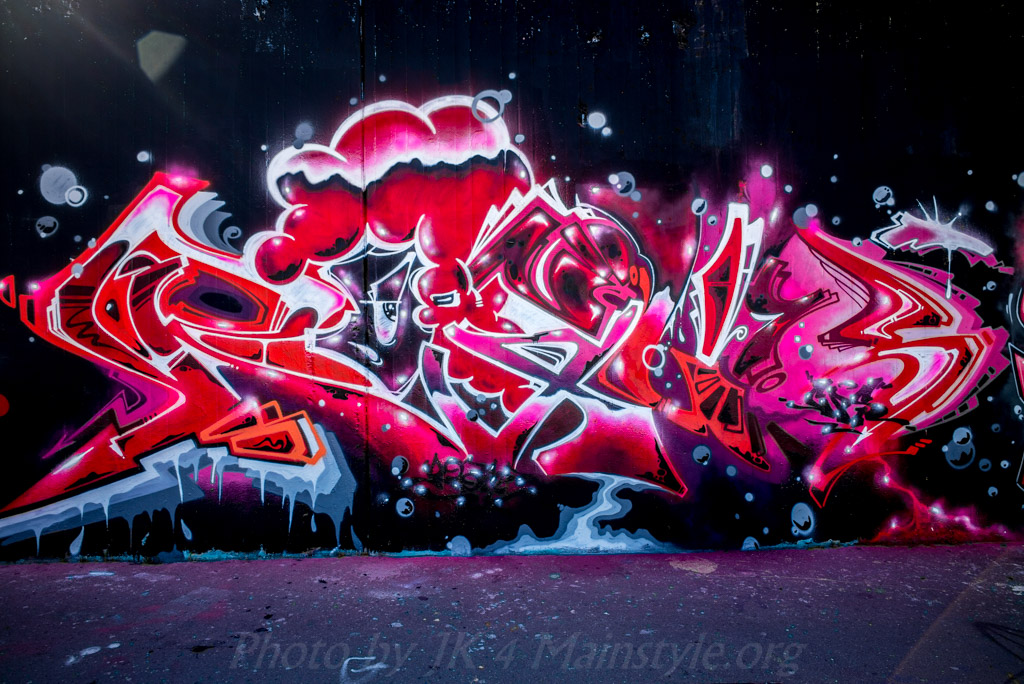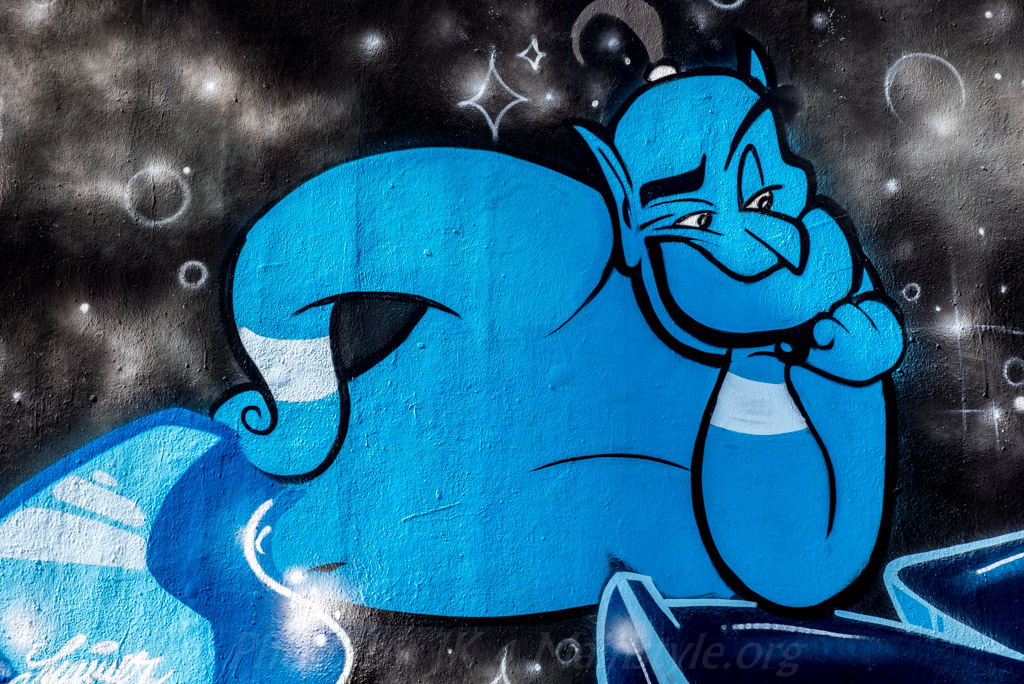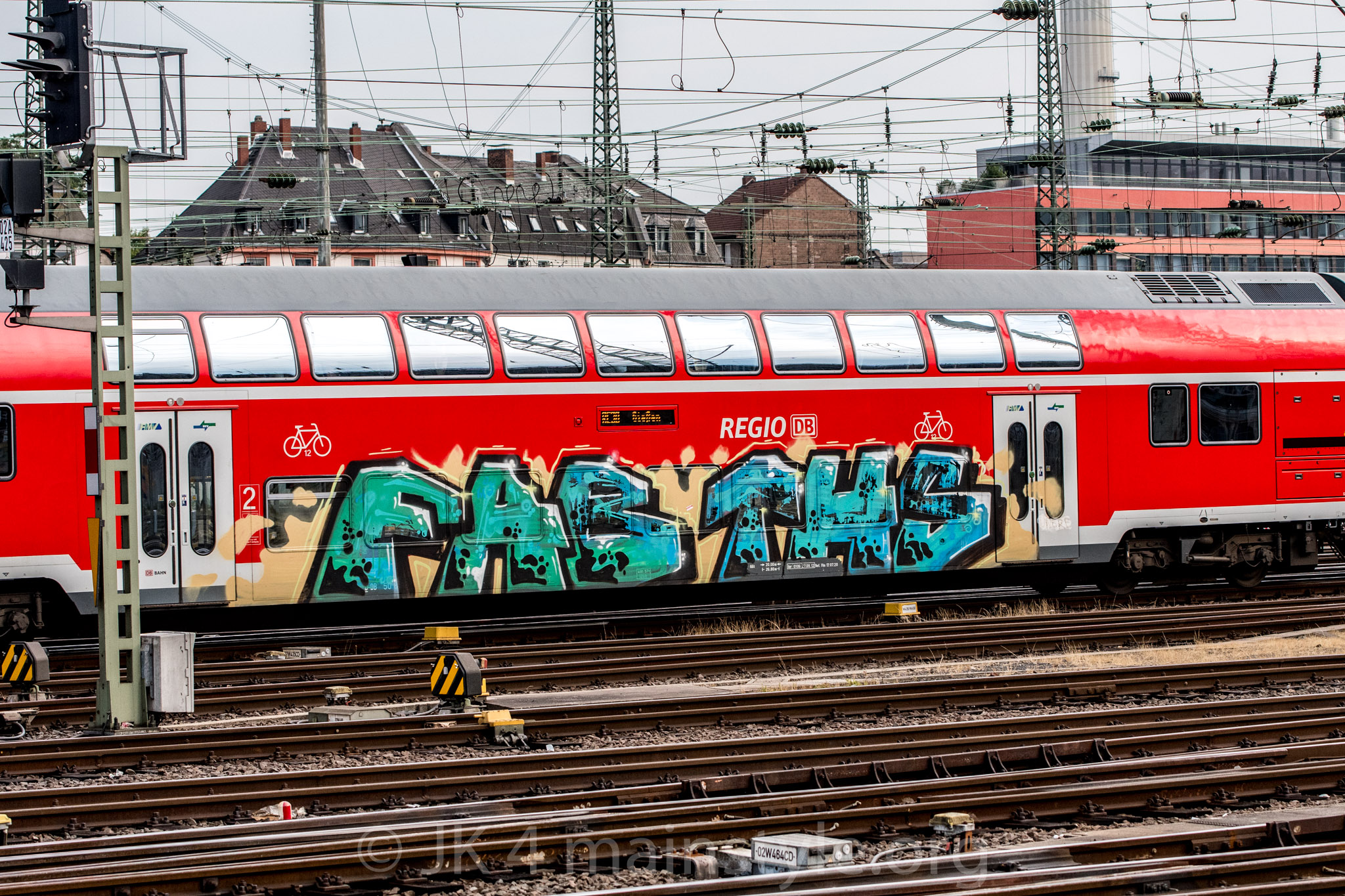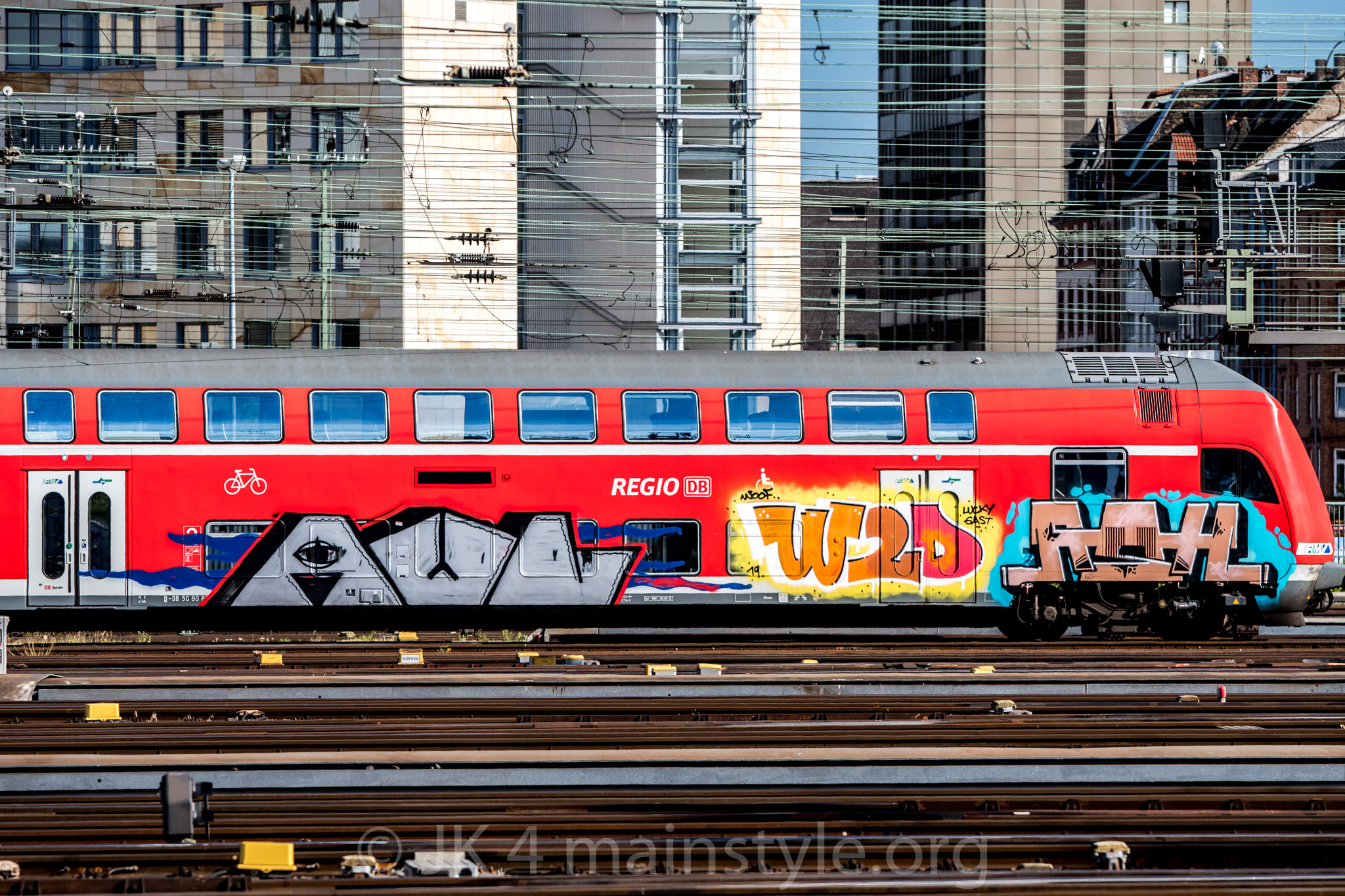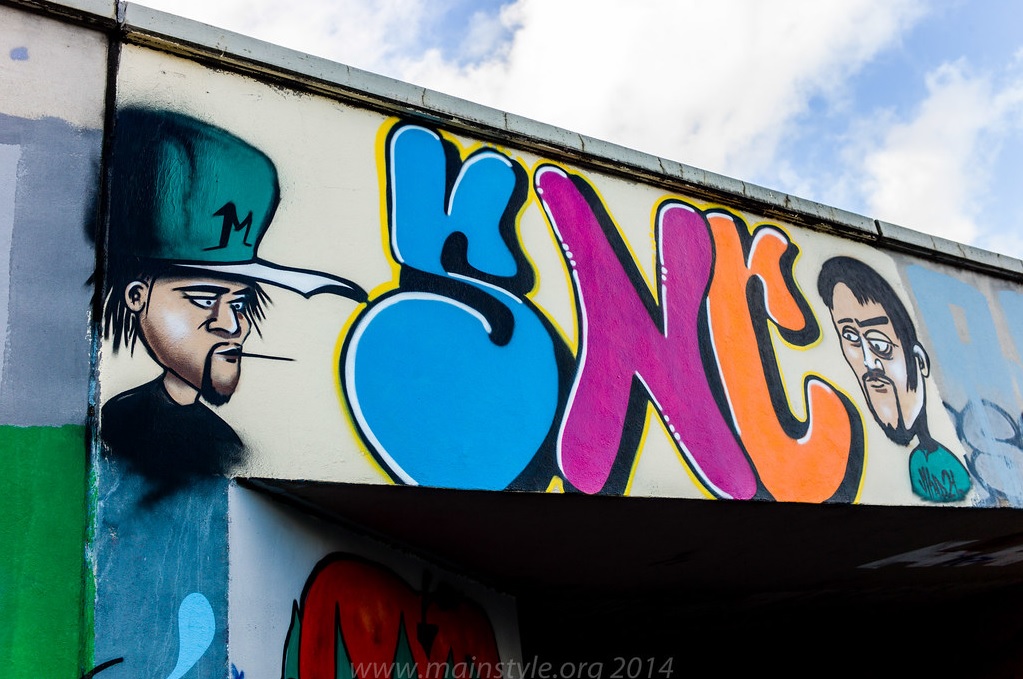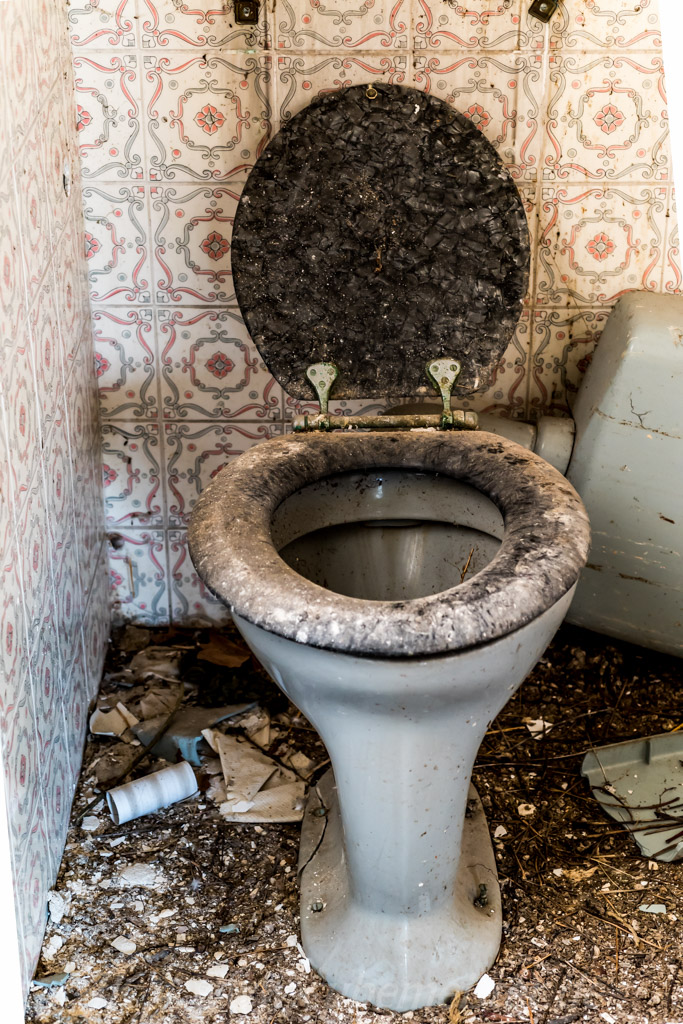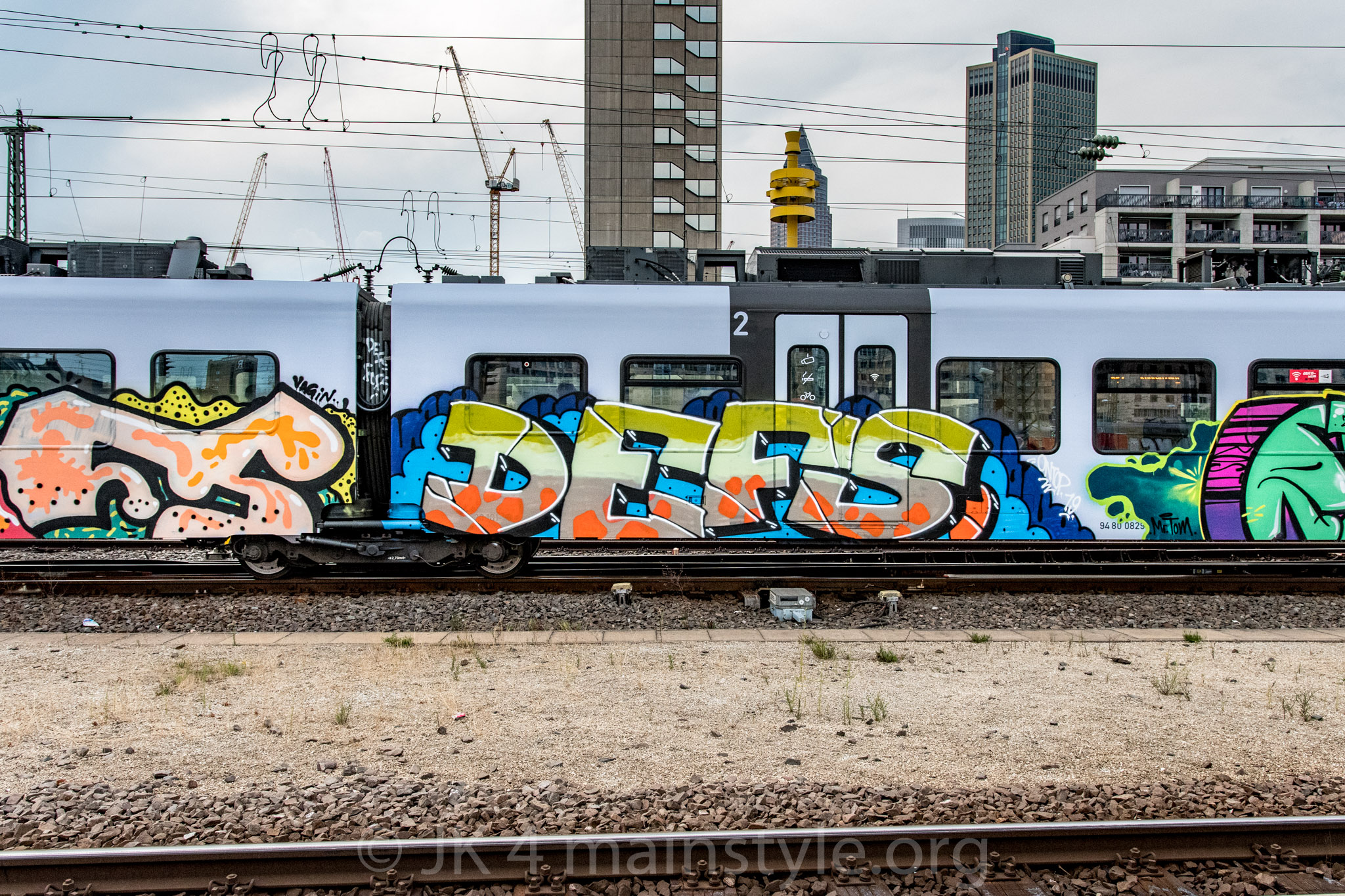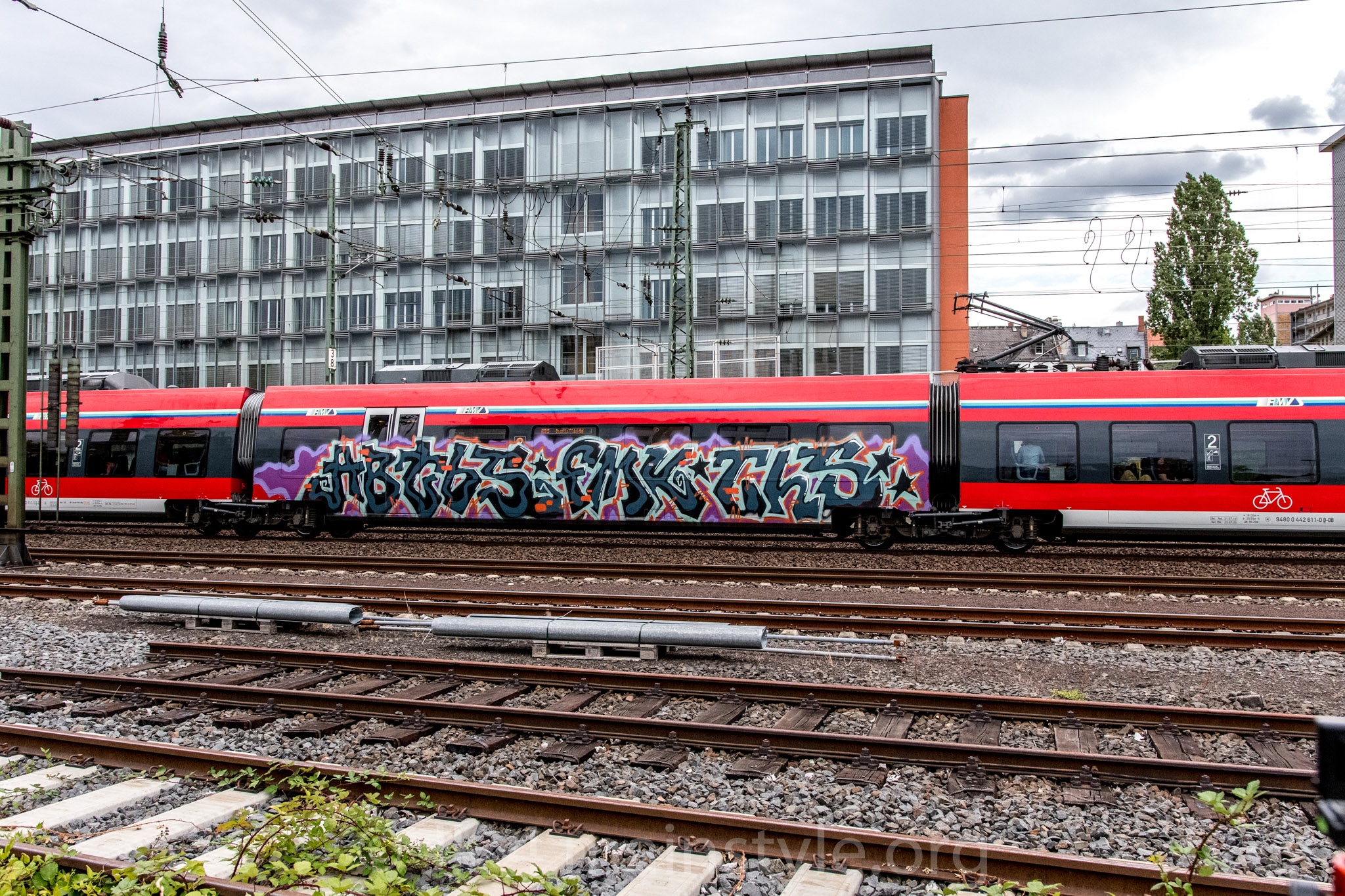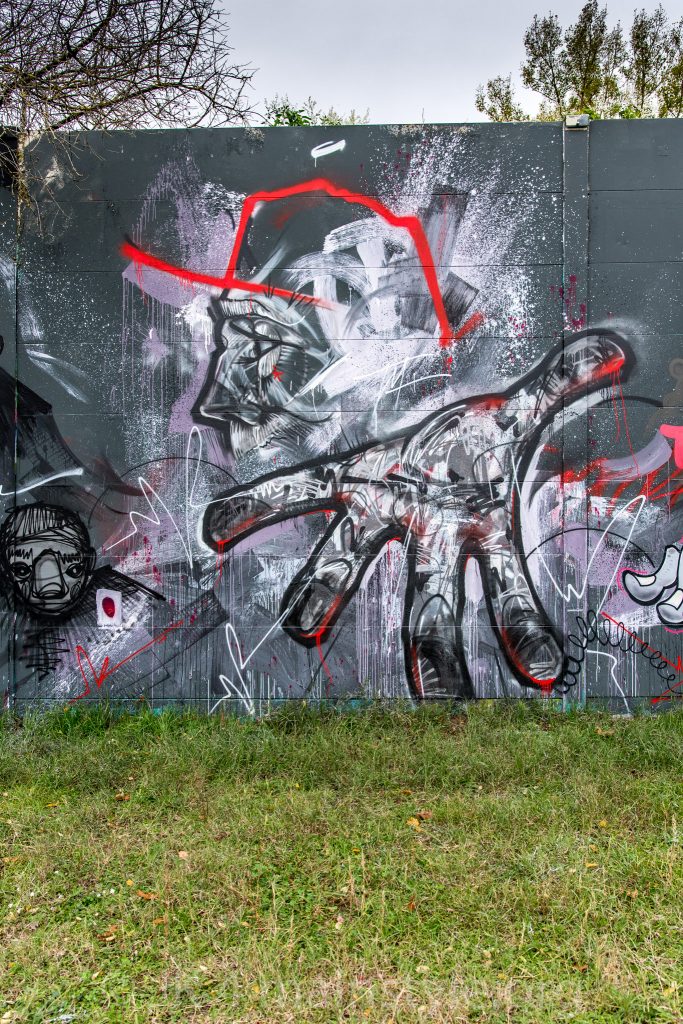The photographer Jörg Udo Kuberek, or just “Fotojörg” for short, started documenting Frankfurt graffiti and street paintings at the end of the 1980s. In the beginning there were political slogans on facades or funny writings on toilet walls, but soon the passionate and motivational seeker came across the colorful wild style, the characters and just cool graffiti. The good stuff.

Over the years, several thousand pictures from the Main metropolis and the region have accumulated – you’d have to print it! The idea for the Mainstyle magazine was born, but initially only seven print editions in black and white were published at the beginning of the 90s. To be exactly, the first one went out on 24th of July in 1990. After a short break with various photo exhibitions on urban street art, but also on other themes such as “Abandoned Places”, Fotojörg went online with Mainstyle in 2011.
The website is a paradise for all graffiti fans with a large fund of works, especially from the Ratswegkreisel, the Friedensbrücke or the Naxos Halle, but also with specials about painted trains, with artist interviews, videos or jam reports. On the platform are not only Pieces from Frankfurt City, but also from the Lincoln Wall in Darmstadt, the outdoor pool in Bad Vilbel or other spots in the surrounding area. Jörg is currently working on a new book about the beginnings of the graffiti scene in Frankfurt and the region, meets with artists who were active at the time and prepares the visual material. Next year the publication about the 80’s and first 90’s is planned, further volumes can still follow.

We talked to Fotojörg in an interview about Mainstyle, the origins of Frankfurt graffiti and the new book. Listen to our conversation here in the podcast in German or read the written and translated conversation below. The text is also peppered with a beautiful selection of graffiti works from the last 30 years.
How did you even start photographing and how did you develop a real passion for documenting graffiti here in the Rhine-Main area?
That was actually a long time ago. I have to think back. I came across graffito or written graffiti sayings in 1987. There used to be political slogans like that. Or as they used to say, shithouse slogans. So you walked into the toilet and there was something. And at some point I went hunting with two films in Frankfurt afterwards. In 1987 and 1988 I saw such political slogans and they were attached to house walls with cans. Some partially also with characters. But very simple comic-like characters. And I started taking pictures of it at that time.
At this time you searched for photo material in the Frankfurt area.
That was the Frankfurt area, right. And then after around one film and a half I came across style graffiti. So that means colorful pictures that were similar to the graffiti in America. This was actually the trigger, there I discovered my passion for these graffitis and for these colorful pictures. Then I went on a search in Frankfurt and found some everywhere. Sometimes I even smelled it when it was freshly painted.

Such a fresh smell, hmmm, almost like at the baker’s.
Yes, Sparvar had a smell of his own back then. You could tell. Or Auto-K or the Dupli Color DIY store cans.

At this time there wasn’t a Canpire Shop yet.
No, there wasn’t a Canpire yet. There weren’t any cans made especially for spraying. It was also difficult to spray and to spray clean. Yes, I think I took pictures for two years and then started to exhibit things. I had made photo exhibitions in youth centres. At some point I also got to know the painters, the Frankfurt painters. Then the pure photo exhibition became a whole week of action. At the next exhibition there were painters, they painted live and I exhibited photos at the same time. When it was a good fit, they even added a DJ who played music at the vernissage or the finissage. Whereby Finissage was not said back then. So it had a jam character. That was at the fourth exhibition and I did it until 1992. But the idea for Mainstyle as a graffiti magazine was already born before. At first that was just about Frankfurt or Frankfurt and the region, as I like to say. Because Bad Homburg also belongs there and Friedrichsdorf or Offenbach, so everything completely around it.

What many users may not even know about your website or followers at Instagram was that there were print editions in the beginning.
Yes, there was. There were actually seven print editions at the beginning. At that time it was still very simply produced. These were actually copies that were stapled together, but they were sent all over Europe. You had to subscribe to it, so there was no shop or anything where we delivered to and where you could buy it.

So then the contact was made by email? Or have there been any e-mails?
It didn’t exist then. So it was really just a phone and a letter at the time. That means, the first issues were given to people by hand and inside there was a coupon, you had to send it to me with 10 marks and then you got the next three issues sent to you. But that spread very quickly. We had more than a hundred subscribers and that went on for two to three years. But then we stopped that.

Why did you stop doing that?
Well, it was a mixture of several factors. The three of us didn’t get along so well anymore, so we made the magazine by three guys. I started an apprenticeship and suddenly I had less time. And there was some friction in the scene, too. That was all at once negative, I had a negative feeling and everything had a negative action. You have at the beginning such a euphoria phase, you get also hyped and everybody is like “Yes, yes, horny, horny!”. But then there are also people who start criticizing and go against you. The time when everyone had enough free time and positive energy was simply over. I think you would have had to take it to another level at that time. They should have started with color prints and we were all not ready for that.

Graffiti only in black and white, there is already missing some of the effect.
Yeah, definitely. Our role model at that time was the Swiss magazine "14k”;. They stayed black and white for a very long time, so over 20 or 30 issues, I think. But they also had it printed professionally, so it looked a bit better. I’ll say this later, we made room for On The Run. This has come after us. And the tuff stuff in full color. I think that was the first graffiti magazine worldwide in full color. It’s from Aschaffenburg. And I think that "On The Run”; was partly black and white in the beginning, partly in colour, the inside was in colour. But later that became full colored. So that’s how it turned out. In retrospect, that was very cool.

Sounds cool, too. You were virtually following the beginnings of graffiti culture in Frankfurt live.
That’s it. So I tried to document it as well as possible and of course I got to know all the first painters. Except for one, I didn’t meet him then. Or several, i. e. the ZIP CREW, or ZIP. He was completely undercover. Nobody knew him and I think only two people saw him back then. I actually got to know all the other painters or was allowed to get to know them. I also got some tips on where what was painted and I always got there very quickly before it was painted over again or crossed again somehow. And yes, I was active and documented a lot until 1993.


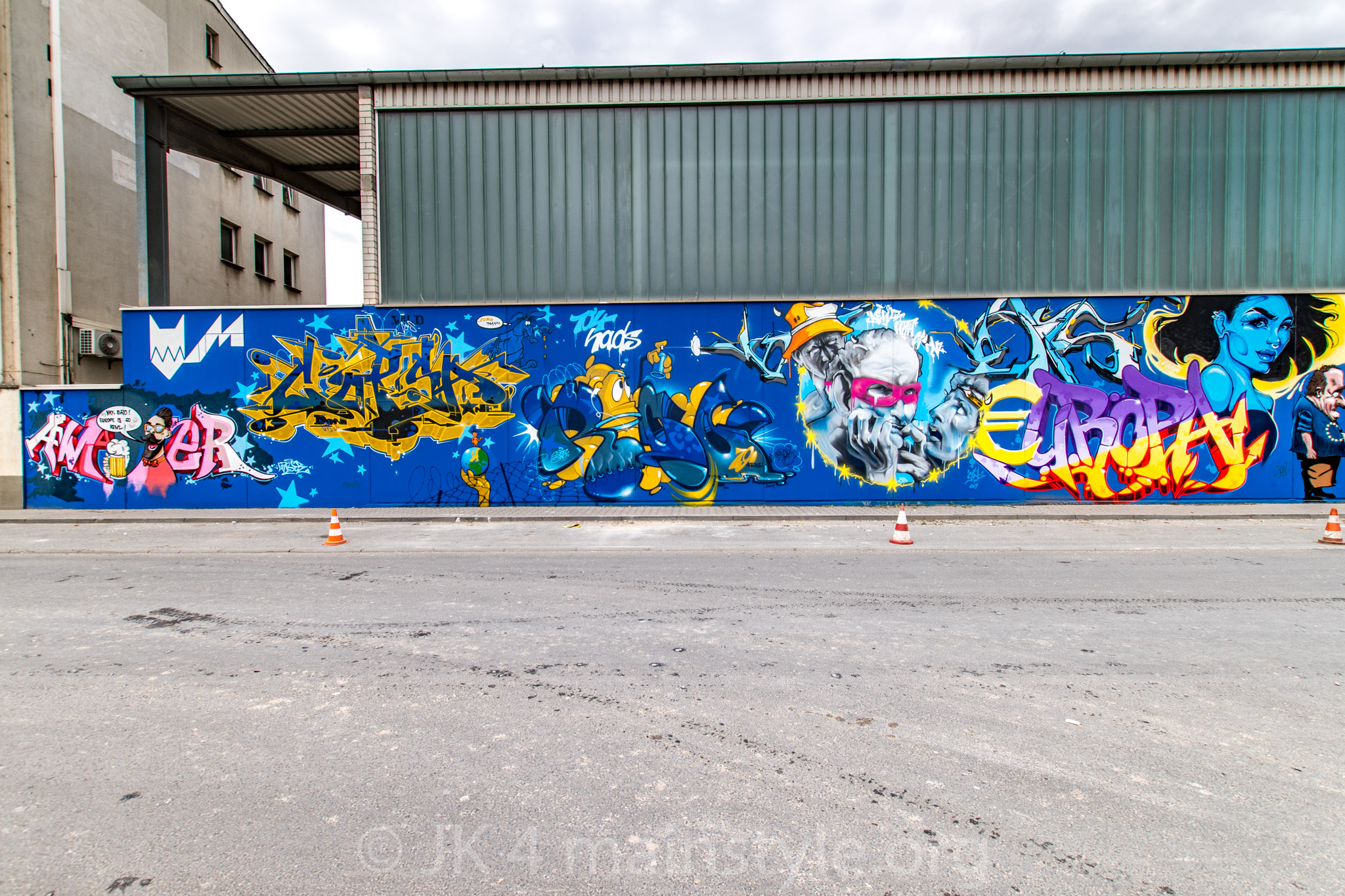
And then sometime the website came and you started to put the photos online.
Yeah, well, I got an email sometime. I don’t know exactly how the guy found me, but that’s an American and he probably lived here at the time around 1992 and his whole youth was shaped by the pictures I took at that time. The American wrote to me sometime, so his name is SIMEONE and he asked me if I still had old mainstyle magazines. That was 2010. And if I still had old photos. He has raved super and I have him then scanned a few things and sent by mail. Meanwhile you have mail, so in 2010. Then he wrote that he would like more issues of the mainstyle and I actually found them in the basement. I sent him all this across the pond and he remembered everything very positively, was enthusiastic and raved about it. Somehow I took that as an impulse and thought to myself, I now bring the old things into the Internet! I now open the mainstyle page and post old stuff! That was the first idea, the first concept and I did it. I’ve posted stuff from ZIP and also from Bomber. I once had an exhibition with Martha Cooper in 2006, I uploaded the pictures there. This was such an exhibition with Helge Bomber Steinmann and the Martha Cooper together. There were his pictures and also photos of me to show the new painters what was painted 20 years ago.

That’s part of history.
Yeah, that’s it. That’s history or old school.

We have the audio here also now through the audio to it, how do you pronounce the title? So Mainstyle, like the river Main or the English pronunciation?
Actually, mainstyle, like the river. But I do say Mainstyle with English pronunciation over and over again. But it is actually originated and should be original, Main-Style, coming from the river Main.
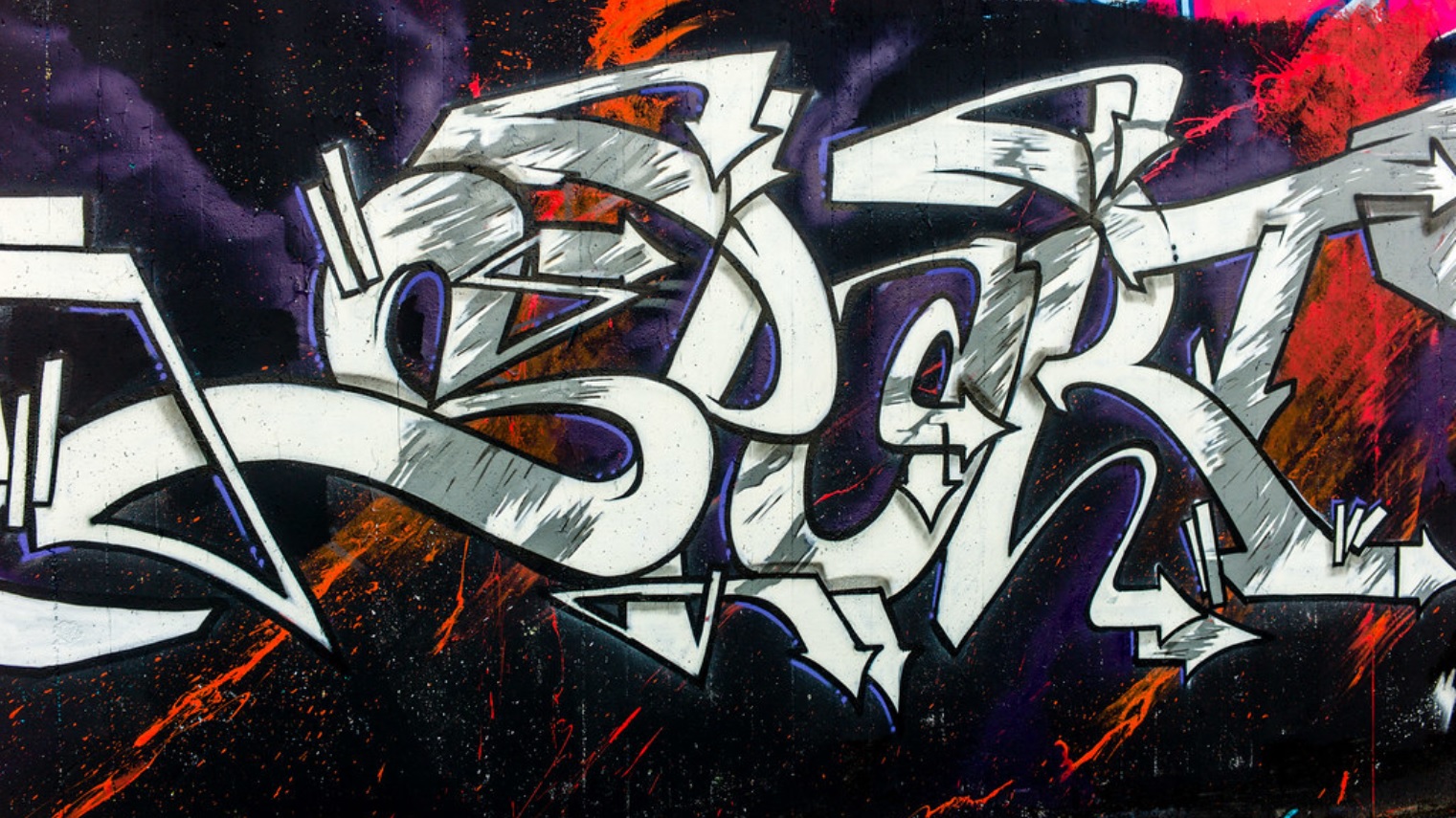
Which is another cool side effect, if you pronounce it like the river name, then it also looks like a pronoun, so mine. Like my own style, I collected it. So your photos, but frankfurter style. Frankfurt fabric, or “Stoff aus Frankfurt”. 😉
Yeah, that’s it. Good stuff from Frankfurt. Stoff aus Frankfurt, greetings to FUEGO at this point!

It is now 2019, so how has that developed so far? Where are you now and what is mainstyle now?
So since 2011, when the site went online, the concept has already changed. At first, I actually just posted the older stuff. Even sometimes in comparison to what’s on the wall today. But that turned over between 2012 and 2013. I have rediscovered my old love and have also gone back to active photography. That means, I had lots of current photos and have also looked in the net whether there are pages that post and publish this. There were pages, but they didn’t necessarily do it to that extent or post everything. Some of them had specialized on tags for example or only on characters. I just find the style writing very interesting and then started to post current things. Usually always a gallery of some kind of event, so those were legal events, where I just took pictures of everything. I then published the most beautiful pictures of them.


For example, the Under Art Construction ECB campaign, where Naxos also participated a lot. I think that was even then over Naxos. This has developed to the point that I actually visit every jam that somehow takes place in the Frankfurt area when I can and also take photographs and upload the photos in the end. In addition, there are trains that have been painted and posted there, but also graffiti from motorways. There are specials for that. Or there is also a special about individual artists who have painted a lot in the Frankfurt area. In addition there are always posts where I point out that there is a jam here and there or an event there. There is also a small calendar, which means you can see what will take place in the next months and meet other interested people there.

Which locations can you recommend here in the region? What are the public spots that you should have seen and where beautiful works are created?
So the main spot in Frankfurt, as far as quantity is concerned now, is the Ratswegkreisel, which has meanwhile been released for painting. I think five years ago, if I remember correctly, it’s legal to paint there. There are not always the most beautiful things, but there are sometimes beautiful concept walls. Then there are also phases where only individual painters do something, then it doesn’t look quite so great, but you definitely have to do that. It’s definitely something to look at. Then there are a few beautiful walls at the Friedensbrücke. That’s where you can go. Whatever is worth it is to come to the back of the Naxos hall, there is also a lot of painting. They don’t have that many walls, but they do things regularly. There’s always some nice stuff there. But then it gets a bit thinner and you would have to drive a bit further out. So in Bad Vilbel, there is another wall at the swimming pool, which is also regularly designed. In Dortelweil there is a noise barrier, which is a bit longer. There you can also paint freely and legally and this is also regularly frequented. So in these places it’s legal, you only have to ask at the Friedensbrücke, I think that’s also the case at the Naxos studio. They have the document, the permission and you can address them and then you get told which wall you can paint when. But you can also go to Bad Vilbel and paint directly at the swimming pool, that’s totally chilly.

Dortelweil I have already mentioned and the Ratswegkreisel always goes. Sure, there’s a few rules you should follow. So you don’t have to go over the newest pictures and maybe you don’t have to paint over the most beautiful ones, because there is a lot of space and you can always find something. It is partly covered, so you can paint in the rain. And for people who like to paint at night: You can also paint at the Ratswegkreisel at night, because it is quite well lit. Then you have a bit of that post-painting feeling. I think two or three years ago at a fair, there were some painters from all over Europe and they went to paint at night. They met there and painted through the night. Yeah, it’s fun!

If you look all these years back now, you can’t put that in a few sentences, but how did the scene and graffiti culture develop? What has changed from your point of view? Are there more fights or less, have you crossed differently in the past or has everything remained basically the same?
Well, that’s really hard to say in the end, because you have to be very close to the scene. I am now an observer of the old times and now again an observer of the modern times because of me from 2010. So first of all it is noticeable that there are other styles, which did not exist before. So for example Anti-Style. The term street art is suddenly there, that didn’t exist before. There was only graffiti. So before 1985 or 1984 graffiti was only these slogans and sayings, there are also masses of books of it. There’s no style in it. So there is always graffiti, but they are actually just sayings. This changed in Germany between 1983 and 1985, especially with the films Wild Style! and Style Wars and similar productions. In the old days, there were fewer groups, fewer people and a smaller scene. Sure, everyone knew each other. Today it is much bigger with many more painters and different groups. There are those who tag much more and paint or bomb less styles. It’s also a bit divided into legal and illegal, there’s also a mix that does both, so they’re day and night painters. And of course, today you cross each other too.
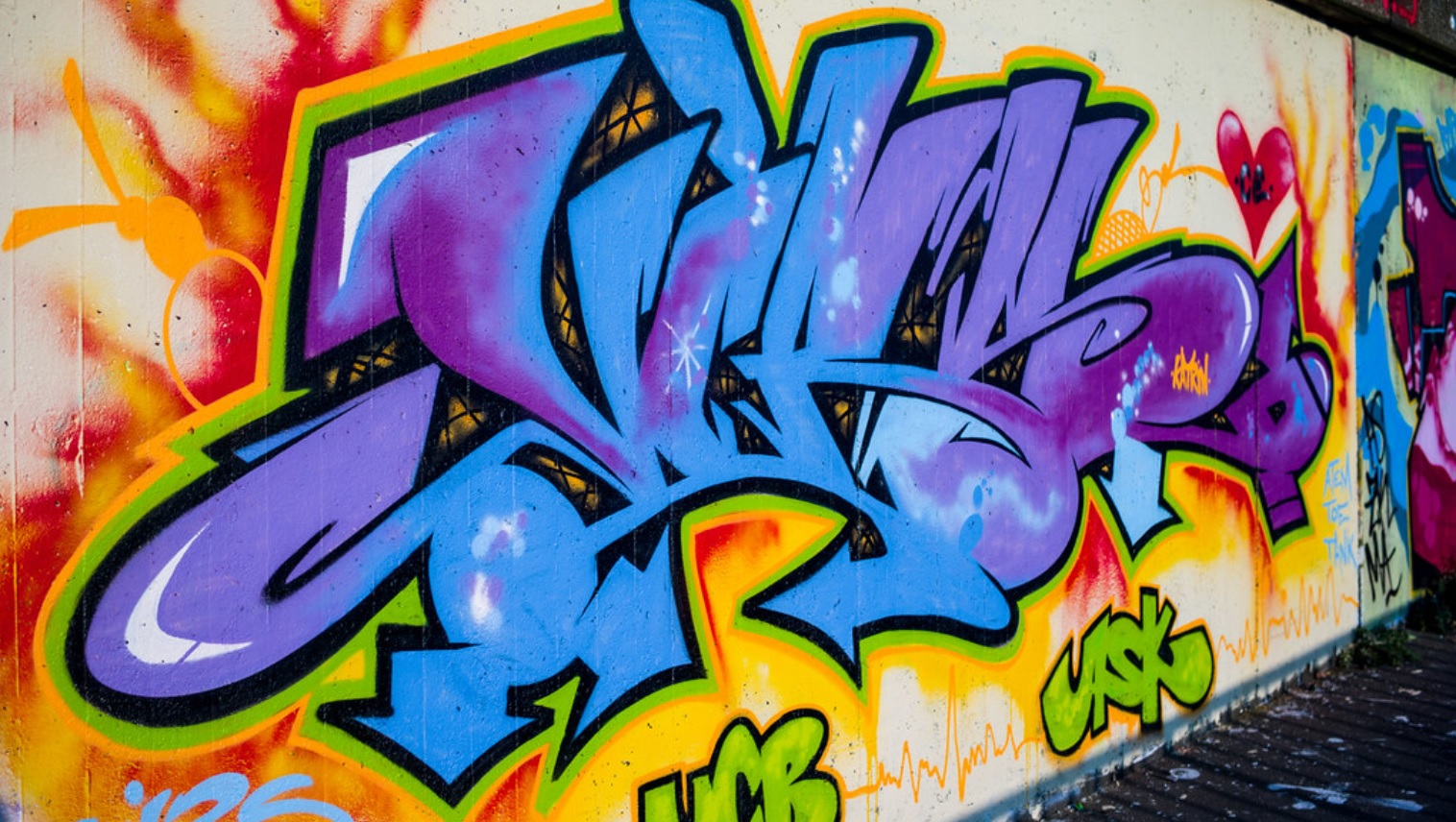
There will always be, and it’s just a part of it.
Yeah, it’s still a battle, too. If you now go over a picture where you haven’t asked and it’s an enemy group, then you get crossed again. In any case, these conflicts still exist. But that is also part of graffiti.

What I noticed here in Frankfurt but also in other cities, there are many more larger murals. I can’t say whether it has increased or decreased in bombing or smaller things, but there are in any case much more extensive things, much more murals. This in turn has a different effect on the population and on the perception of the whole phenomenon. More is tolerated, at least the bigger things, that has opened the door again for new artists, that they can paint more works somewhere. And yes, this has gradually led to greater acceptance. Is that how you feel about it?
I agree. I have also talked with many visitors of these jams or with passers-by who just walk past the Ratsweg circles, but who sometimes stop and ask questions, so I talked with many people. I say so the mainstream goes so in the direction that they all taggen somehow find shit. I wouldn’t say that. But as soon as it gets colorful and looks halfway beautiful, they find it better than gray. The large murals, the large facades, they all actually find beautiful and that is now also part of the cityscape of Frankfurt. There’s not just one, but luckily there are several. And it’s getting more and more. I believe that the acceptance of the smaller styles will grow as well. So this means that the reverberation is also seen differently. But I still think there are these two camps. So most people don’t like tagging, they don’t understand that either. Also older people speak about it exactly in the language.

You can also see from the fact that graffiti has completely arrived in society, that everyone knows Banksy and the stuff around it, then many video spots adopt graffiti elements, you see it in films, in the lettering of advertising banners. So this also shows that companies and institutions thinking in terms of market economy recognize that people apparently like this and that it can be used to earn money. It’s already become popular.
Absolutely. Around 2010 I had little to do with Graffiti Stuff and in the last few years I noticed that a whole industry has developed for it. Special markers are produced. In the past, you simply took the Edding or different versions of Eddings or even from other manufacturers. But there are now countless companies that specialize in providing perfect tools for young painters, male and female alike. The cans have a different pressure somehow, partly with low pressure or high pressure. There’s some super blatant stuff there. There’s all the caps you need. In the past, if you wanted to have a skinny, you had to put a needle in the front somehow. So you had to build yourself needle caps. That’s all there is today and it’s easy to order and buy. This means that in any case there is an industry that serves this need. But at the same time there are also many companies that know if they want to address the target group, because of me skaters or this corner, then they know that graffiti is a good way to get there.


But there is also the fact that the people who used to paint had something to do with hip hop back then. And the people who started it back then. They’re a little older today, just like me. So 40 or even 50. And they end up in positions where they can decide about content. I always hear advertisements where I think: Geil! They dug up ancient hip hop stuff and it still works! I think that more of the old hip hop and graffiti will end up in commercials. So by the fact that the meanwhile older sacks are also allowed to help shape it.

Graffiti is subculture and comes from the underground. Is it still graffiti when it suddenly becomes popular?
That’s a very difficult question. I do not believe that you can or do not want to evaluate this in conclusion. For me, there’s this day painting and night painting. And night painting, that’s what many bombs or bombing say. It’s subculture, this sneaking, hiding, fast painting, fast going. And day painting is rather that which is somehow not punished and not punished socially. I was about to say, "This will be tolerated. But meanwhile it is recognized, appreciated and belongs to it. The children start at the age of ten or eleven and practice painting. So it’s already with cans. There are workshops in the Bornheim youth shop, where you can learn on Wednesdays. It’s nothing forbidden, as long as they don’t paint at night. But I think there really are these two worlds and real graffiti is for me – this is my very personal opinion – rather bombing and not something like "I paint for an exhibition and sell the things for 3000 Euro”;. But that’s my personal opinion. There are others who think differently and say everything is graffiti.

Then came this saying: “There is graffiti and everything else is just street art”. It’s all part of one thing with many different sides, some of which may even contradict each other, but still every element belongs to it. And if you see it completely, then the sticker ring and the stencil things are also part of it. Of course no lines were painted there, but it’s still Urban Art, that’s also a new word. But you focused on the graffiti, in big and small, also style writing, tags and moves. What about the just mentioned stickers and stencils?
Yeah, well, that’s nice of you to bring that up. I forgot to mention that earlier. In the past, people didn’t say street art about it, but it was a part of graffiti. This means that solid stickers were already painted and glued at that time. I must confess to my shame that I took these off and collected them. So some of you I’ve confessed to in this day and age. At first they had a neck, but then they were very happy because they saw a sticker that was 30 years old, which of course would not exist otherwise. So I saved them, but then the boys weren’t so good at talking. They didn’t think that was funny. At some point I got these things for free, so I didn’t take them off anymore, but I got them for free. But to get back to that, it wasn’t street art, it was graffiti. To my knowledge, the first stencils were painted by ZIP, who also learned a similar or suitable profession during that time. He had already built it into his graffiti at that time and that wasn’t a street art, it was just graffiti. And today, so everything else there is like this knitting art, which is on a Boller. That would be street art. I would still see Stencil at Graffiti, Sticker as well. Everything else, so whether this is now some Lego pictures glued on the street, that is street art. But sometimes it also reminds me of the time in kindergarten where we made things and painted. I don’t want to be disrespectful, and if people think it’s nice, let it happen.

You collected the stickers then, almost too passionate.
The stickers were all on the S-Bahn back then, maybe for a week or two, but the cleaning crew then made it all go away. And I just had to do one every now and then.


We were talking earlier about why somebody paints. Painting for the sake of painting often reminds me of the mandala painting from Buddhism, that is this meditative process with sand, where it is only a matter of painting or scattering a picture over several days with small colored grains of sand, and then simply wiping it away again. Well, it’s about the making itself.
Yeah, right, so it’s the process. A painter from Bad Homburg, whom I had interviewed, happened to tell me that recently. He is interested in the process and does not care at all about the end result. He does not necessarily have to preserve or document the final result because he lived this process and that was the most important thing. That’s when he pulled out his energy and his satisfaction. That was very interesting. And I’m keen on the result again. There are several reasons why people paint. It used to be that way, of course it’s about Fame or it’s about attention. But the painters I met at the time also wanted to improve themselves. They have actually always tried from one picture to another to paint for themselves even cleaner or to paint something special and to improve the technique even more. And of course, it was also about painting bigger. But they didn’t have in mind that there was a target group that is now so and so old and you would have to take the and the colors and the and the shape.
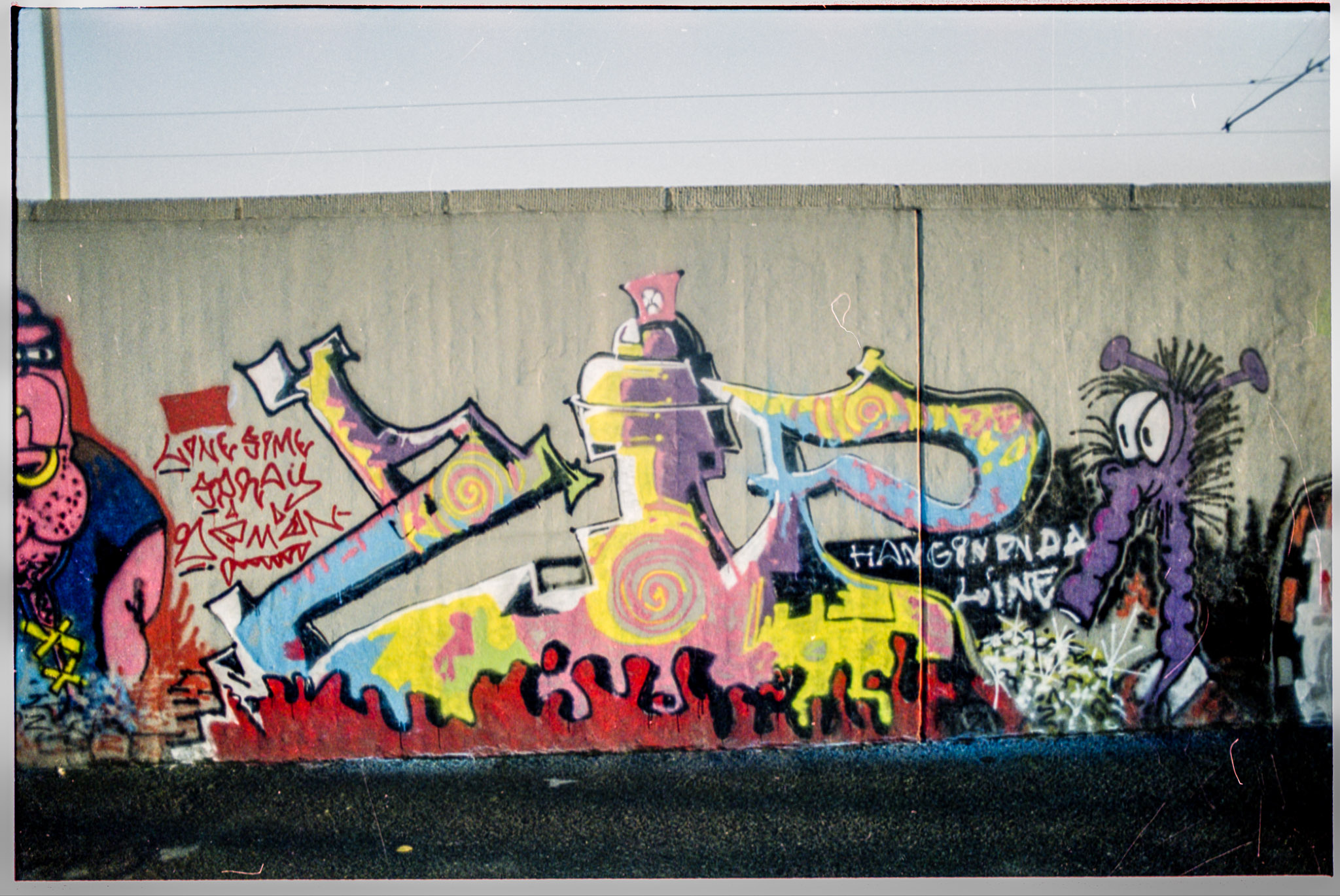
They painted for themselves.
That’s right, they painted for themselves. And when they have looked at the thing the next day, then they have pee-pee in their eyes, because they said: "Geil! I got it! I got it! It got clean, and I did it the way I imagined it would. The colors look the way I thought they would. " They’ve achieved their own goals. Or even such crass actions that they painted a spot where nobody had painted before. Sure, it has to do with fame and recognition again. When you do special things, you naturally get special attention. That’s what everybody says, and everybody admits it. So of course you did it because you also wanted attention.

What kind of equipment do you use?
Meanwhile I have the luck that I was allowed to buy a few cameras and I photograph with full format, partly also with crop format and I have really a lot of different cameras. For the Ratsweg circles I also bought extra lenses, because there is not much space, so I need wide angles. Very powerful wide-angle lenses. And these are different manufacturers, whether one takes now a Canon or a Nikon. But I’ve been with Nikon for 30 years, by nature. In the meantime I also started taking pictures with Leica, because I also took pictures of Lost Places. There was also an exhibition in 2017. So I’m not just photographing graffiti. But with the Leica I took some pictures of the graffiti and the photos are a little bit different. At least the coloured ones are great without end and basically you can print all the stuff. When I take a picture, I don’t just do it for the web or the homepage, but I do it in a way that you could print it on a big canvas or print it in books or magazines. I always try to make sure that you can use it again sometime and that it doesn’t just get mouldy at home or on the internet. There are a lot of photos. Well, I don’t know what else you can do with it. You could fill a lot of books. In the last five years, 10,000 pictures have been collected at the Ratswegkreisel alone. So 10,000! Totally perverted! Of course there are some doubles or bad ones, but that’s a hell of a lot! I have to see what the future holds. Maybe the pictures somehow end up in magazines and then they are outside and in circulation for eternity.

Who knows how the whole thing will develop further. Maybe all this is building up more and more here in Frankfurt and there will be a proper street art or graffiti museum one day. Then all those photos would definitely be material for archiving. You say 10,000 is a lot, but I don’t know if there exist so many photos from today and especially from the past. I’m sure there weren’t that many people who were so eager to take pictures.
The museum would be a dream. From the photographers, so there’s two or three more. Nowadays, they call them spotters. Or street art hunter. There are still two or three of them, I think they have as many pictures. But what’s interesting is, nobody’s got them all. I don’t have them all either. And such a wish idea is then that at some point people put all their pictures together, throw the material together in a heap, and you then have a kind of graffiti museum and can bring it all together centrally. That’s a hell of an idea!

For other photographers or graffiti fans who like to photograph, what equipment can you recommend? What are good cameras to photograph graffiti?
I’ve now established that full format is not so clever. But it is actually much more clever if you buy a medium-priced camera that has this crop factor. So not a full-format chip, but different systems. I’d take Nikon’s DX. You can connect relatively inexpensive lenses with top focal lengths. That means from a blatant wide angle to a 300 mm telephoto lens. These focal lengths are better achieved with the smaller chips. The resolution is now extremely high, so it starts at 20 megapixels. That’s plenty for the pressure. It’s not that heavy and it’s not that expensive. That’s where you come in, if you’re lucky under 1000 euros. Of course, it is also always possible with a compact camera for 300 euros. But you’ll see that when you print it. That’s why I recommend, if someone seriously wants to take photos, then you should at least start in the middle area, then you get something out of it.

So a medium price reflex with maybe two lenses for the start. You can also photograph smaller parts of the graffiti, but if you want the whole work, the angle must be the same.
That’s it. There are also such small zooms, they have 10 mm to 20 mm, these are the smallest. They are perfectly suited, you have three or four meters distance and you get six meters on it and that without distortion. The GoPros, those are the action cams. They also have an extreme wide angle, which then turns into Fish Eye. So you can make Fish Eye, but that’s this barrel distortion, but then you distort the graffiti. This is then no longer the original proportion that the artist actually conjured up on the wall. I think it’s okay to take your own picture of a graffiti. So it’s not frontal, maybe from the side or distorted because of me either. You can do that, but my intention is always to document it and to be as close as possible to the colours, the forms and the proportions. Then of course I can’t take a fish eye like that or I can’t tell anyone. On the other hand you can make exciting pictures with it again. So it’s got something. Sometimes I do both. I make a row only the Doku pictures at the Ratswegkreisel and then I take another lens and make again crazy cool things for me. Most of the time these pictures have more tension or a wow-effect, but they are not suitable for a documentation. Even if I photograph a piece and cut the day off, that doesn’t work.

That’s the signature.
That’s right. So I have to document it completely or I just do my WoW pictures. And that’s why I think it’s absolutely right to take a close look at the camera beforehand. So check left, look right, look up, everything I want is on it and then I take the shot.


Yeah, that’s important. Because when you realize at home that you have forgotten something and then run there again the next day, then it can be gone again.
That’s right, I did. And that’s happened to me a million times. There have been painted elaborate pictures and characters, I went the next day again, because I wanted to take another picture to be on the safe side. But then other people were already there and just overpainted it. Then I thought, okay, that’s only been 36 hours. So this is what happens. It’s just fleeting, too. That is, if you are there, then do it right, then you don’t regret it afterwards either.

Apart from the website, you are currently working on another project. You want to publish a print again, but this time not a magazine, but a real book about the graffiti history of the Rhine-Main area with a course over several years.
Yeah, that’s it. I think 1989 was the year I did an interview with the Frankfurter Neue Presse and I said: Yes, I’m looking for a publisher now and I really want to make a book! And back then, I think I had 450 pictures. Now this idea has come up again or matured. I’ve been thinking about the last five or six years, what you could make a book about, what it could look like and with whom you could make it. Of course, I’ve looked at what structures there are today. So something like book on demand and how to get a book out today, so self-published. If you do your own publishing or if you really go to a large publishing house, that has all the advantages and disadvantages. I also scanned my old pictures for the last five years, which was very time-consuming. Because one also has to buy a real scanner, one cannot take just any one. Then you have to rework it, you have to index it and I think I have about 4000 photos from the old days. There’s someone who has more, but I haven’t been able to contact them yet. He’s still resisting. On the subject of who I’m making a book with. So yes, maybe I’ll catch him again, because he has a lot of pictures from the old days.

Maybe even a short story about how I actually got there. Well, it’s actually very topical now that we’re working on it. I made a simple photo book. With Poster XXL I believe, but you can also do it somewhere else. But that was with old ZIP and HEXA pictures. Actually for my family and for me as a memory, because we grew up with these pictures. I had prints in my room and my siblings had them in photo albums. I then ordered five photo books and someone had seen that and said: Yes, come on, order some more. Then we ordered ten more, I offered these things and someone bought one of them. Niklas. And it turned out that he was not only a painter, but also documented and photographed at that time. After a week we both said: Book! Shall we make a book? It is actually time to make a graffiti book about the beginnings of graffiti in Frankfurt. We then sat down together, developed a concept and thought about how it should be structured, what we would like to take in and what we would like to tell. Then there is a third one who will mainly take care of the layout and the prepress. Now we are in the middle of doing interviews with old painters and collecting stories and facts. If we put anything in the book, it should be as full as possible. Sure, if we get an exciting rumour, we’ll take it in, but then we’ll also identify it as a rumour and not write that it was. The main target are the beginnings of graffiti in Frankfurt and the region, so also in Bad Homburg and Offenbach. Mainz is not among them, nor is Wiesbaden, but the greater area around Frankfurt is to be covered. We still have to see how far we can go into modern times, so we are still scoping, so to speak.


You can choose any date for the finish of the first timeline and then the following material you publish in volume number 2.
Yes, definitely, we could do that. At the moment we are still in the ramp up phase and landed in 1992 or 1993. Until then we already have a lot and try to finish it as fast as possible and get it out right.

I’m really looking forward to the book. It will not only be a photo documentation, there is also a lot of history. So these interviews, you do a lot of research and write down the whole history and connections.
It should in any case also be a book what a non-graffiti insider can address. It’s supposed to be understandable. So not only insider talk, but also what kind of someone who might be interested in the topic recently and would like to know how it started in Frankfurt. The normal reader should also be able to find himself there again and understand that. One of the aims is also to mention as many painters as possible, or preferably all of them. Whether it’s the Kings, i. e. King of Tunnel, King of Hall, King of S-Bahn or whatever, they are of course part of it, but also the others should be mentioned somehow. And of course the development should be described. How has this developed over the years from the very beginning and what has it become? These are high goals, but it’s our turn.
Are you still looking for support for the book? Do you need help in any way or are you still looking for photo material?
So you can definitely get into the book, that’s what I call it. We are happy to accept pictures from the old days. They’d just have to donate it to us so we can print it. We have set up a website for this purpose: www.FrankfurtGraffiti.de. There you also have an email address where you can email the photos or where you can ask us questions. It will also be a non-commercial book, so in the end it should not bring any money, but it should go to zero if everything works out. Anyone who wants to make something available to us, be it an article or pictures, will of course be mentioned in the book as a supporter. More information can be found on the website. We are happy about everything that comes and what we can use for the book, because that is just our main goal. We would like to report something about the Frankfurt graffiti painters and such a book about Frankfurt does not yet exist.

INFOTHEK
Mainstyle
![]() Email: webmaster@mainstyle.org
Email: webmaster@mainstyle.org
![]() Website: https://www.mainstyle.org/
Website: https://www.mainstyle.org/
![]() Facebook: https://www.facebook.com/MainStyleFfm/
Facebook: https://www.facebook.com/MainStyleFfm/
![]() Instagram: https://www.instagram.com/mainstylefrankfurt
Instagram: https://www.instagram.com/mainstylefrankfurt
![]() Flickr: https://www.flickr.com/photos/mainstyle/
Flickr: https://www.flickr.com/photos/mainstyle/
![]() Dailymotion: https://www.dailymotion.com/mainstylefrankfurt
Dailymotion: https://www.dailymotion.com/mainstylefrankfurt
![]() Clothing: https://shop.spreadshirt.de/frankfurtdesign/
Clothing: https://shop.spreadshirt.de/frankfurtdesign/
![]() Magazine Download: https://www.mainstyle.org/index.php/mainstyle-magazin-download/
Magazine Download: https://www.mainstyle.org/index.php/mainstyle-magazin-download/
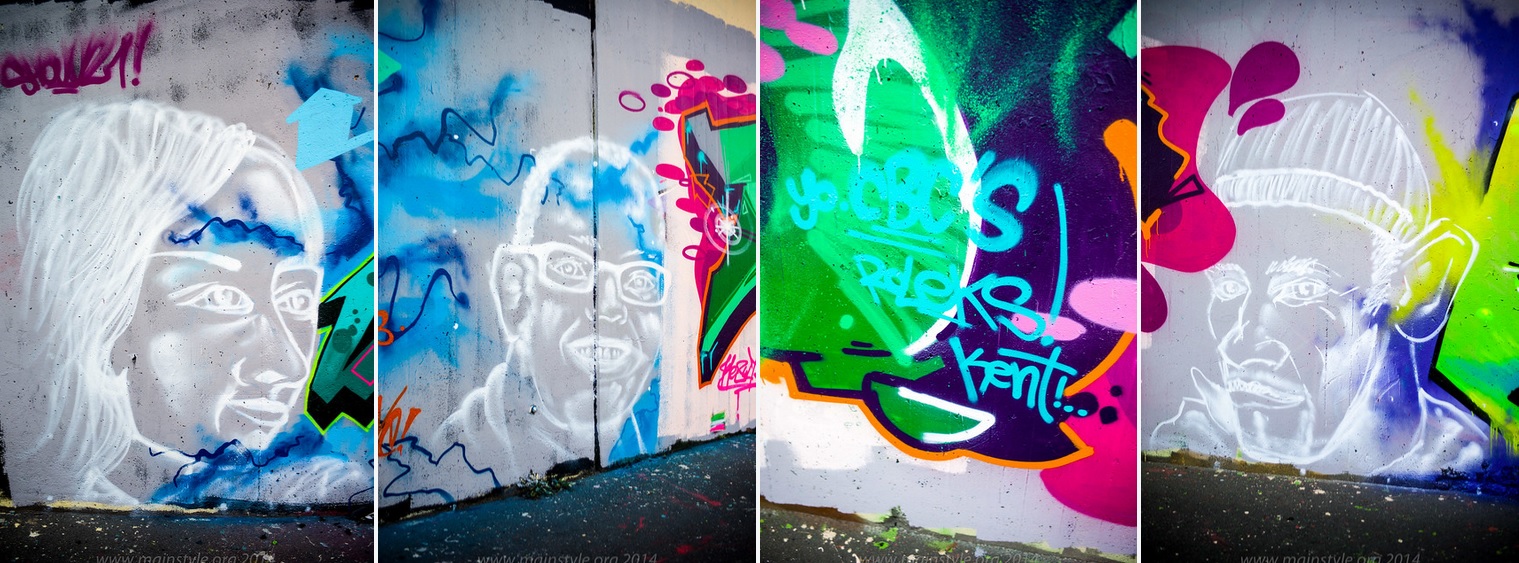
Other Projects from Fotojörg
Fotodesign: http://fotodesignkuberek.de/
Lost Places: http://cubemeister.de/
Exhibition: https://verlasseneorte.info
Graffiti Frankfurt: https://www.graffitifrankfurt.de/

Frankfurt Links:
Naxos Atelier: http://jugendladen-b.junetz.de/2_0_2_offenes_atelier.html
Canpire Shop: https://www.canpire.com
Stoff aus Frankfurt: https://stoffausfrankfurt.de
Jugendladen Bornheim: http://jugendladen-b.junetz.de

Graffiti Stuff
14k: https://www.14k.ch
On the Run: http://www.ontherun.de
Movie Style Wars: https://www.youtube.com/watch?v=f9KxbaSU-Eo
Movie Wildstyle: https://ok.ru/video/261856430845
Sparvar: http://www.spraycolor.de
Dupli Color: https://www.motipdupli.com
Auto-K: https://www.auto-k.de






















